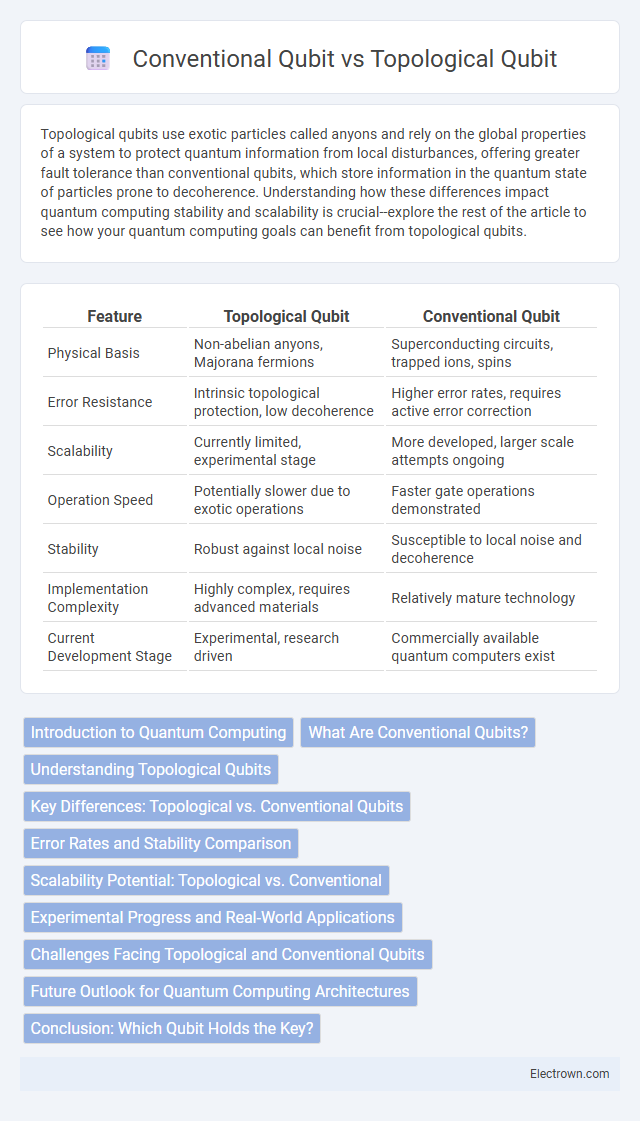Topological qubits use exotic particles called anyons and rely on the global properties of a system to protect quantum information from local disturbances, offering greater fault tolerance than conventional qubits, which store information in the quantum state of particles prone to decoherence. Understanding how these differences impact quantum computing stability and scalability is crucial--explore the rest of the article to see how your quantum computing goals can benefit from topological qubits.
Table of Comparison
| Feature | Topological Qubit | Conventional Qubit |
|---|---|---|
| Physical Basis | Non-abelian anyons, Majorana fermions | Superconducting circuits, trapped ions, spins |
| Error Resistance | Intrinsic topological protection, low decoherence | Higher error rates, requires active error correction |
| Scalability | Currently limited, experimental stage | More developed, larger scale attempts ongoing |
| Operation Speed | Potentially slower due to exotic operations | Faster gate operations demonstrated |
| Stability | Robust against local noise | Susceptible to local noise and decoherence |
| Implementation Complexity | Highly complex, requires advanced materials | Relatively mature technology |
| Current Development Stage | Experimental, research driven | Commercially available quantum computers exist |
Introduction to Quantum Computing
Topological qubits leverage the principles of topology to encode quantum information in a way that is inherently resistant to local noise and errors, offering a promising path toward more stable quantum computing compared to conventional qubits, which are highly sensitive to environmental disturbances. Their use of exotic particles called anyons enables fault-tolerant computations by storing information non-locally, contrasting with the fragile superposition states in standard quantum bits. Understanding these differences is crucial for advancing Your ability to develop scalable, reliable quantum computers in emerging quantum technologies.
What Are Conventional Qubits?
Conventional qubits, primarily realized through superconducting circuits or trapped ions, utilize two-level quantum systems to represent and manipulate information. These qubits are highly sensitive to environmental noise, which leads to decoherence and operational errors, posing significant challenges for scalability in quantum computing. Error correction techniques and qubit coherence times remain critical factors influencing the performance and reliability of conventional quantum processors.
Understanding Topological Qubits
Topological qubits leverage the principles of topology to encode quantum information in non-local states, significantly enhancing their resistance to decoherence compared to conventional qubits. Unlike traditional qubits that rely on fragile superpositions of quantum states, topological qubits utilize anyons and braiding operations to store information, enabling fault-tolerant quantum computation. This robustness promises substantial improvements in error rates, making topological qubits a promising candidate for scalable quantum computers.
Key Differences: Topological vs. Conventional Qubits
Topological qubits leverage anyons and braiding properties in two-dimensional space to encode information, providing inherent protection against local noise and decoherence, unlike conventional qubits that depend on superposition and entanglement in systems like superconducting circuits or trapped ions. The robust error resistance in topological qubits enables more stable quantum computations, potentially reducing the overhead for quantum error correction compared to conventional qubits. Your choice between these qubit types impacts the scalability and fault tolerance of quantum computing architectures.
Error Rates and Stability Comparison
Topological qubits exhibit significantly lower error rates due to their inherent protection from local noise and decoherence, utilizing non-abelian anyons to encode information in a fault-tolerant manner. Conventional qubits, such as superconducting or trapped ion qubits, face higher susceptibility to environmental disturbances and require extensive error correction protocols to maintain stability. The robustness of topological qubits against quantum decoherence positions them as superior candidates for scalable, reliable quantum computation compared to conventional qubit architectures.
Scalability Potential: Topological vs. Conventional
Topological qubits offer greater scalability potential than conventional qubits due to their inherent resistance to local noise and decoherence, which reduces error rates and the need for complex error correction protocols. Conventional qubits typically require extensive error correction and closely controlled environments, limiting large-scale integration and increasing overhead. The fault-tolerant nature of topological qubits positions them as a promising path toward scalable quantum computing architectures.
Experimental Progress and Real-World Applications
Experimental progress in topological qubits has shown promising improvements in error resistance due to their non-abelian anyon properties, distinguishing them from conventional qubits which suffer more from decoherence and noise. Real-world applications of topological qubits aim to enhance fault-tolerant quantum computing and secure quantum communication, offering scalability advantages that conventional qubits currently lack. Your ability to harness topological qubits could accelerate developments in quantum cryptography and complex simulations, driving more reliable and robust quantum processors.
Challenges Facing Topological and Conventional Qubits
Topological qubits face significant challenges such as maintaining non-abelian anyons at extremely low temperatures and controlling quasiparticle poisoning, which can disrupt their fault-tolerant properties. Conventional qubits struggle with decoherence and error rates due to environmental noise and imperfect gate operations, limiting their scalability. Your ability to develop stable qubits depends on overcoming these material and technological limitations to achieve reliable quantum computation.
Future Outlook for Quantum Computing Architectures
Topological qubits offer enhanced error resilience through their inherent protection against local noise, promising more stable quantum computations compared to conventional superconducting or trapped-ion qubits. The future of quantum computing architectures likely hinges on integrating topological qubits to achieve scalable, fault-tolerant quantum processors. Advances in materials science and braiding operations are critical for realizing practical topological quantum computers that surpass the coherence limitations of existing qubit technologies.
Conclusion: Which Qubit Holds the Key?
Topological qubits, leveraging anyons and braiding operations, offer inherent error resistance compared to conventional qubits reliant on fragile quantum states. Your quantum computing systems could benefit from the increased stability and scalability topological qubits promise, potentially unlocking more reliable quantum algorithms. Despite challenges in fabrication and control, topological qubits hold the key to fault-tolerant quantum computing and long-term quantum advantage.
topological qubit vs conventional qubit Infographic

 electrown.com
electrown.com